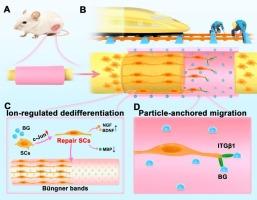生物活性神经导管通过离子调节去分化和粒子锚定迁移的双重功能促进周围神经再生
IF 7.9
2区 材料科学
Q1 MATERIALS SCIENCE, MULTIDISCIPLINARY
引用次数: 0
摘要
长节段周围神经缺损的再生仍然是一个重要而具有挑战性的临床问题。神经再生的关键步骤包括雪旺细胞向修复表型的去分化,然后它们有序地迁移形成引导轴突伸长的bngner带。然而,由于缺乏刺激的生物活性因子,目前神经导管的修复普遍较慢。在这项研究中,我们设计了一种生物活性玻璃微球嵌入神经导管。这些微球释放的离子激活c-Jun,诱导雪旺细胞去分化。同时,涂覆在导管表面的微球提供了物理锚定位点,加速了整合素-β1介导的雪旺细胞的粘附和有序迁移,促进了本文章由计算机程序翻译,如有差异,请以英文原文为准。

Bioactive nerve conduit enhance peripheral nerve regeneration through dual functions of ion-regulated dedifferentiation and particle-anchored migration
The regeneration of long-segment peripheral nerve defects remains a critical and challenging clinical problem. The key step in nerve regeneration involves the dedifferentiation of Schwann cells into a repair phenotype, followed by their orderly migration to form Büngner bands that guide axonal elongation. However, due to the lack of bioactive factors for stimulation, the repair of current nerve conduits is generally slow. In this study, we designed a bioactive glass microspheres-embedded nerve conduit. The ions released from these microspheres activate c-Jun to induce Schwann cell dedifferentiation. Meanwhile, the microspheres coated onto the conduit surface provide physical anchoring sites, which accelerate integrin-β1-mediated Schwann cell adhesion and orderly migration to facilitate Büngner bands assembly. This study confirms that dual-function bioactive glass microspheres promote nerve regeneration through ion-regulated dedifferentiation and particle-anchored migration, offering a novel approach for the design of nerve conduits.
求助全文
通过发布文献求助,成功后即可免费获取论文全文。
去求助
来源期刊

Materials & Design
Engineering-Mechanical Engineering
CiteScore
14.30
自引率
7.10%
发文量
1028
审稿时长
85 days
期刊介绍:
Materials and Design is a multi-disciplinary journal that publishes original research reports, review articles, and express communications. The journal focuses on studying the structure and properties of inorganic and organic materials, advancements in synthesis, processing, characterization, and testing, the design of materials and engineering systems, and their applications in technology. It aims to bring together various aspects of materials science, engineering, physics, and chemistry.
The journal explores themes ranging from materials to design and aims to reveal the connections between natural and artificial materials, as well as experiment and modeling. Manuscripts submitted to Materials and Design should contain elements of discovery and surprise, as they often contribute new insights into the architecture and function of matter.
 求助内容:
求助内容: 应助结果提醒方式:
应助结果提醒方式:


